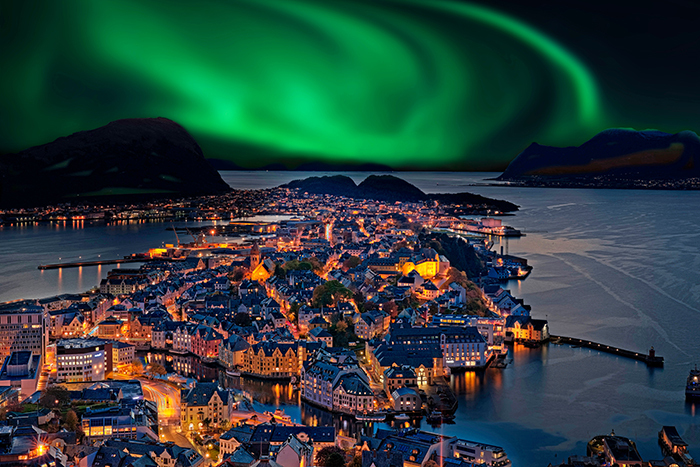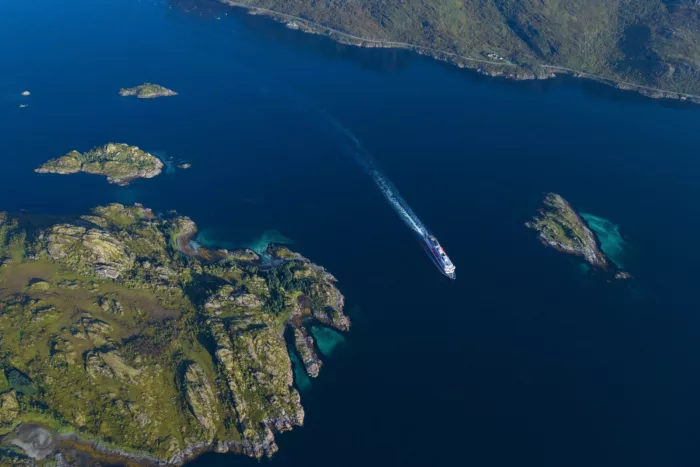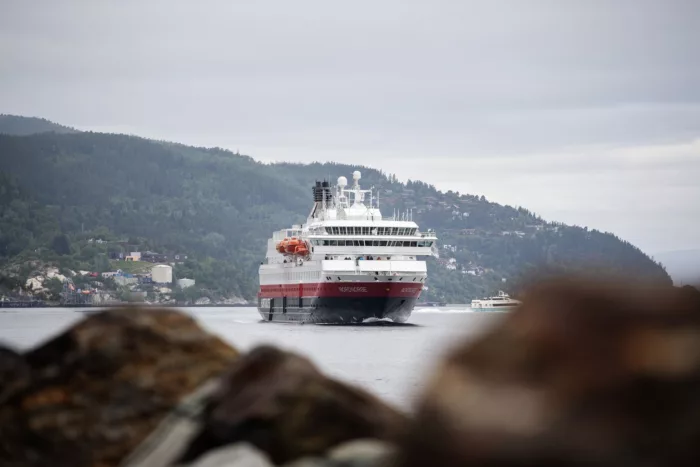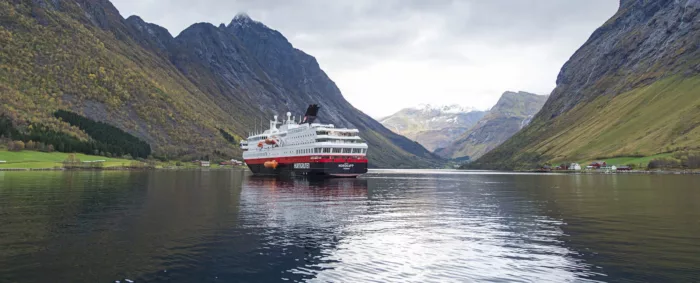
The Hurtigruten Museum: A turbulent journey through time
Stokmarknes may appear remote and devoid of heritage, but the town’s sleepy exterior masks real importance as Hurtigruten’s home port. The biggest clue? A ship in a bottle – that happens to be 1:1 in scale
Nestled between the rugged splendour of Norway’s northernmost dominion rests the somnolent town of Stokmarknes; perched across an imposing rim of tundra that yawns across the horizon.
Radiating with barely 3,400 settlers, and temperatures that seldom climb beyond 15 degrees Celsius, you’d be forgiven for dismissing Stokmarknes as Scandinavia’s heavy-eyed glacial stereotype.
The sort of place where nightlife terminates in the afternoon, excitement stems from receiving other people’s junk mail and locals communicate using sternly prolonged silence.
Yet, you’d be wrong. You see, Stokmarknes remains one of Norway’s best-kept secrets.
The 610-acre settlement houses people from 25 nations, many attracted by lucrative job opportunities generated by the fishing industry.
Maritime activity remains the basis for the town’s gravitas, although there’s more to the area than aviation and hospital services for the Vesterålen region.
More Hurtigruten loveliness
- Hurtigruten: The origins of Norway’s shipping hero
- A complete guide to Hurtigruten Coastal Express
- The Norwegian liners that saved Tom Cruise’s Mission: Impossible
To those who fantasise about paperclips, Stokmarknes is a bustling Norwegian administration area. Serving Nordland County’s Hadsel Municipality and providing an intricate work-life balance amid a healthy community, this is where equality – and equalisation of living conditions – remain steadfast. It’s bureaucratic poetry in motion.
However, to those who enjoy culture and anarchy, Stokmarknes is also home to alternative rock band Madrugada (“the period of time between midnight and sunrise”) and renowned filmmaker Kim-Remi Kjesbu. Entertainment and nightlife may not glow to the zesty hum of larger settlements, but there’s an undercurrent of pure mobocracy that pulsates when not on duty.
It therefore doesn’t take long to establish this Norwegian paradise as the place to be. The future seems set for prosperity where contentment is more than a pipe dream. And yet, it’s upon looking back that you understand the town’s remarkable place in Norwegian culture; a culture set to land on homely shores as expedition operations diversify.
Step forward and take a bow, Hurtigruten.

Hurtigruten: More than a shipping service
Norwegian coastal travel has ushered a profound impact on the nation's social and economic fabric. Hurtigruten, often dubbed the "lifeline of Norway," has been that vital conduit between remote coastal communities and the rest of the country since its inception in 1893. A bit like having Robin Knox-Johnson as your butler.
There’s bravery and resilience in the company foundations, too. When no other souls were brave enough to map and tackle the country’s rugged (and – let’s be frank here – dangerous) coastline, Captain Richard With took the challenge and established Hurtigruten’s foundations when no one else could.
The contemporary Norway, that so many countries now envy, would simply not exist without the line’s continued efforts. It's no exaggeration that almost every morsel of Norwegian success can be traced back to a Hurtigruten vessel; even Tom Cruise utilised these ships when the going got tough.
However, Stokmarknes’ place in Hurtigruten history isn’t always clear. Should you delve into the history books, you’ll find that the first Hurtigruten voyage departed from Trondheim on 2nd July 1893, and arrived in Hammerfest three days later (45 minutes ahead of schedule, we might add). Most historians leave it at that. Job done. End of story. No mention of Stokmarknes.

If you search behind the well-told origin story, Stokmarknes’ role as the centre for Hurtigruten activity suddenly becomes clear. The idyllic village may not have been the genesis port for sailing activity, but it’s where Richard With started the company more than 120 years ago. It’s home.
The company’s headquarters can therefore be found within Stokmarknes’ main parameters, making the town a vital cornerstone for Norwegian transport and trade. And, naturally, Hurtigruten keeps its museum within the confines of its home port; but it’s no ordinary archive.
While typical museums consist of dusty artefacts and unhinged mannequins, the Hurtigruten Museum challenges that befouled stereotype. Rather than echoing as a repository of maritime recordings, Hurtigruten has instead created a testament to Norway’s enduring spirit and the country’s intimate relationship with the untamed sea.
Originally established to celebrate the legacy of the Hurtigruten Coastal Express, the museum now resonates as a beacon of cultural heritage. It’s become more than a showcase of history from behind closed doors, and has instead expanded into a direct reflection of Norway’s impressive coastal shipping achievements.

As such, the significance of the Hurtigruten Coastal Museum to the people of Norway cannot be overstated. The museum preserves this rich history, showcasing everything from historical ships to artefacts and exhibits that narrate the Hurtigruten story.
It’s worth remembering that this is more than a shipping brand. Hurtigruten, and the subsequent museum, have become an extension of the Norwegian people. It’s an indispensable part of Norwegian life. It's a place where visitors can immerse themselves in tales of maritime adventure, resilience, and innovation, gaining a deeper appreciation for the ingenuity and determination that characterised Norway's formative years.
However, the journey of the Hurtigruten Museum has not been smooth sailing. Like the ships it celebrates, the museum has faced its share of storms. It’s taken local ingenuity and grit to prevent the beloved museum from becoming a footnote in history.
Fate may have had sorrowful intentions, but was up against it. As if the Norwegian mantra would ever permit such cessation…

Turbulent waters: Challenges and triumphs of the Hurtigruten Museum
Financial difficulties and administrative challenges have often threatened the Hurtigruten Museum’s existence. At several points, dwindling visitor numbers and rising operational costs have cast doubt over the museum's operational future.
Yet, the resilience embedded in Hurtigruten's DNA came to the fore, as the museum's supporters rallied to keep Norway’s cultural treasure afloat.
One of the most significant challenges materialised during the global financial crisis of 2008. Like many cultural institutions worldwide, the Hurtigruten Museum saw a drastic reduction in funding and visitor numbers. As people struggled to make ends meet, aspects such as culture, heritage, tourism and art were the first to suffer and the last to recover.
With tourism depended upon as a major source of revenue, the economic downturn hit hard. The museum's management had to make tough decisions to stay operational. This period of austerity was a grim reminder of the museum's vulnerability, highlighting the delicate balance between cultural preservation and financial viability.
In response to these challenges, the Norwegian government, recognising the museum's cultural and historical importance, stepped in with financial support. In fact, governmental funding became a lifeline, much like the Hurtigruten service itself, ensuring the museum could continue its mission of preserving and promoting maritime heritage.
These funds were crucial in stabilising the museum's operations and allowing for much-needed renovations and updates to the exhibits. The government's intervention underscored the significance of the museum not just as a tourist attraction but as a vital part of Norway's national identity.
It seems that the relationship between Hurtigruten and Norwegian congruence remains akin to Richard Burton and Elizabeth Taylor; they simply couldn’t live without each other.

Anchored in heritage: The museum's revival and modernisation
Financial support from the government did more than just keep the museum doors open; it sparked a period of rejuvenation and modernisation. Patrons embarked on ambitious projects to enhance the visitor experience and broaden its appeal, cementing the establishment as a prime tourism hotspot.
One of the most notable initiatives was the restoration of a certain historical vessel (more on that in a bit), transforming a legendary ship into a floating exhibit that offered visitors tangible connections to the past. No dusty mannequins are lurking within homemade replicas here – it’s the real deal.
Additionally, the museum leveraged digital technology to enhance its storytelling capabilities. Interactive exhibits, virtual reality experiences, and multimedia presentations were introduced, making the museum more engaging and accessible to a diverse audience.
These innovations not only attracted more visitors but also helped the museum reach a global audience, connecting people from all over the world to Norway's rich maritime heritage. Of course, museums do this sort of thing all the time. Like sending out a flare for attention; except Hurtigruten pushed the boat out and emitted a Bat-signal that punched through the glass ceiling and into the atmosphere.
The Hurtigruten Museum also intensified its community engagement efforts, recognising that its success depended on the support and involvement of the local faction. Educational programs, workshops, and events were organised to foster a deeper connection between the museum and the residents of Stokmarknes and beyond.
We’d say they’ve been more than successful, ensuring that the museum remains a cherished institution for generations to come.

MS Finnmarken: The ship in a bottle
Various nations pay tribute to their logistical heritage, but nobody does it quite like Hurtigruten. Walking along the Stokmarknes waterfront, it’s hard to miss the dominating glass building that so often blots out the sun.
Except, unlike the typical glass building upon the shoreline, there are no soulless offices and work cubicles located within. This is something far more interesting and ultimately unique.
Drawing closer, clever lighting illuminates the exhibit. A ship; standing with stoic dignity in age-old livery. And when we say a ship, we mean it. This is no replica. This is not a half scale model. This is a 1:1 scale legend – Hurtigruten’s very own MS Finnmarken from 1956.
Of course, the ‘ship in a bottle’ couldn’t just be any old fleet member. MS Finnmarken was one of the most iconic vessels in Hurtigruten's fleet, representing a golden era of Norwegian coastal voyages.
Built at Blohm & Voss shipyard in Hamburg, Germany, the ship was designed to offer a blend of passenger comfort and cargo functionality. With its sleek lines and sturdy construction, MS Finnmarken quickly became a beloved symbol of Hurtigruten's efforts to unite Norway and bring prosperity.

Over years of service, the ship weathered countless storms and witnessed the transformation of Norwegian society, serving not just as a means of transportation, but as a floating ambassador of Norway’s hospitality. Think Royal Yacht Britannia, but for the masses.
Following almost 40 years of flawless service, MS Finnmarken was retired from operations in 1993. Of course, when a ship from the ‘golden era’ hit retirement, that usually meant only one thing – a date with the shipyard in the sky. Not here, though. No, Sir!
Recognising the ship’s historical significance, Hurtigruten, along with local enthusiasts, made the remarkable decision to preserve the vessel. Instead of being scrapped, the ship was carefully transported to Stokmarknes, where it became the centrepiece of the Hurtigruten Museum.
In an extraordinary feat of engineering, the 2,000-ton ship was lifted onto land and placed inside a custom-built structure, allowing visitors to explore it as they would a stationary museum exhibit.
Visitors can walk through the ship's preserved interiors, experiencing an era otherwise relegated to the history books. Any shipping enthusiast should treat a visit here akin to The Holy Door at St. Peter’s Basilica in Vatican City. We’d thoroughly recommend it.

From stormy seas to smooth sailing: A bright future ahead
Today, the Hurtigruten Coastal Express Museum stands as a vibrant testament to the resilience and adaptability of both the institution and the maritime service it honours. The turbulent times it endured have only strengthened its resolve to preserve and celebrate Norway's coastal heritage. And, with turbulence and strife, comes a newfound value of respect – almost like a right of passage.
The museum's evolution from a struggling entity to a modern, dynamic institution is a story of triumph, much like the voyages of Hurtigruten ships navigating those treacherous stretches of Norwegian coastline.
As it continues to evolve and grow, the museum will undoubtedly remain an integral part of Norway's cultural landscape, inspiring future generations to appreciate and cherish their maritime heritage.
So, next time you find yourself in Stokmarknes, don't just pass by—drop anchor and set sail on a journey through time. The Hurtigruten Coastal Express Museum is worth every second spent on-site.
Just try not to feel envious of the 3,400 settlers who get to view the ‘ship in a bottle’ each and every morning. We have failed there…















